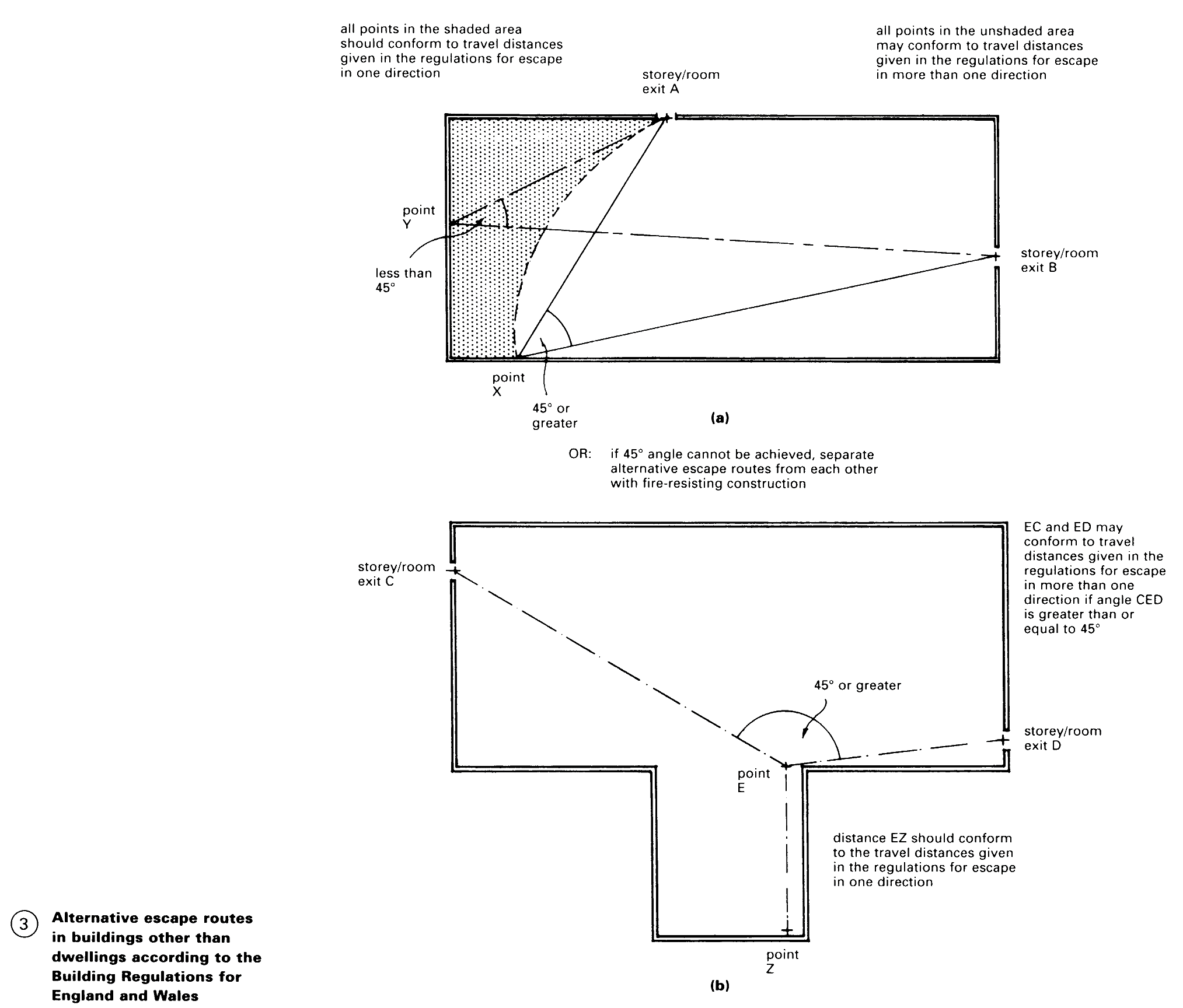Horizontal and Vertical Escape Routes
The number of escape routes and exits required depends on the maximum travel distance that is permitted to the nearest exit and the number of occupants in the room, area or storey under consideration.
Generally, alternative escape routes should be provided from every part of the building, particularly in multistorey and mixed-use buildings. Areas of different use classes (e.g. residential, assembly and recreation, commercial, etc.) should have completely separate escape routes.
Below are examples of typical maximum permitted travel distances in various types of premises. If, at the design stage, the layout of the room or storey in not known (for instance, in a speculative office building) then the direct distance measured in a straight line should be taken. Maximum direct distances are two thirds of the maximum travel distance.
- institutional buildings: 9m in one direction, 18m in more than one
- office and commercial buildings, shops, storage and other non-residential buildings: 18m in one direction, 45m in more than one
- industrial buildings: 25m in one direction, 45m in more than one.
There are more stringent and detailed requirements for places of special fire risk and plant rooms.
Note how the travel distances are much reduced where escape is possible in only one direction. However, this is only suitable where the storey or room contains few people (e.g. less than 50). Rooms at the beginning of an escape route may only have one exit into the corridor; in this case the single directional travel distance should apply within the room and the two directional travel distance should apply to the distance between the furthest point in the room and the storey exit.
The layout of the exits from a room or storey may be such that from certain parts of the room they do not offer alternative escape routes. Figure (3) shows regulations as applied to two types of room configuration. If the angle of 45 degrees cannot be achieved, then alternative escape routes separated by a fire-resisting construction should be provided, or the maximum travel distance will be that allowed for one direction of travel.

The number of exits and escape routes required depends also on the maximum number of people in the area under consideration. Below are typical requirements:

The minimum width of horizontal escape routes is also determined by the number of people using them. Typical values are:

The design of escape routes must take into account planning considerations such as:
Inner rooms. More stringent rules apply to these than in dwellings, such as reduced travel distances, restrictions on use and occupancy as well as construction and the provision of fire detection equipment.
Relationships between horizontal escape routes and stairways. It is important to avoid: the need to pass through one stairway to reach another; the inclusion of a stairway enclosure as the normal route to various parts of the same floor; linking separate escape routes in a common hall or lobby at ground floor.
Common escape routes by different occupancies. These should be fire protected or fitted with fire detection and alarm systems. Escape from one occupancy should not be via another.
Escape routes, design factors. Fire protection to escape corridors should be provided for in all residential accommodation, dead ends and common escape routes. Other escape corridors should provide defence against the spread of smoke in the early stages of the fire. To prevent blockage by smoke, long corridors (>12m) connecting two or more storey exits should be divided by self-closing fire doors. Fire doors should also be used to divide dead-end corridors from corridors giving two directions of escape. See (4) for typical arrangements.



Vertical escape routes. These are provided by protected escape stairs of sufficient number and adequate size. Generally, the rules requiring alternative means of escape mean that more than one stairway is required. The width of the stairs should allow the total number of people in the storey or building subjected to fire to escape safely. Wide stairways must be divided by a central handrail.
The width should be at least that of the exits serving it, and it should not reduce in width as it approaches the final exit. Typical minimum escape stair widths, depending on the type of building and the number of people they serve, are as follows: 1000mm for institutional buildings serving up to 150 people; 1100mm for assembly buildings serving up to 220 people; between 1100mm and 1800mm for any other building serving more than 220 people, depending on the number of people and number of floors.
Each internal escape stair should be contained in its own fire-resisting enclosure and should discharge either directly, or by means of a protected passageway, to a final exit. As protected stairways must be maintained as a place of relative safety, they should not contain potentially hazardous equipment or materials. These restrictions do however allow the inclusion of sanitary facilities, a lift well, a small enquiry office or reception desk, fire protected cupboards and gas meters.
Reductions in the level of fire resistance are allowed on the outside wall of a staircase, depending on the proximity to other openings in the fagade.
Basement stairs need special attention. The danger of hot gases and smoke entering the stair and endangering upper storeys means that at least one stair from the upper storeys should not continue down to the basement. In continuous stairs, a ventilated lobby should separate the basement section from the section serving the upper floors.
External escape stairs are usually permissible as an alternative means of escape, but should be adequately protected from the weather and fire from the building. They are not suitable for use by members of the public in assembly and recreation buildings.
Access for Fireeghters. Provision should be made in design to allow firefighters good access to the building in the event of a fire, and to provide facilities to assist them in protecting life and property.
Sufficient access to the site for vehicles must be provided to allow fire appliances to approach the building. Principal appliances are ladders, hydraulic platforms and pumping appliances. Access roads for fire appliances should be at least 3.7 m wide with gates no less than 3.1 m. Headroom of 3.7m for pumps and 4.0m for high-reach appliances is required. The respective turning circles of these appliances are 17m and 26m between curbs. Allow 5.5 m wide hardstanding adjacent to the building, as level as possible (not more than 1:12), with a clearance zone of 2.2 m to allow for the swing of the hydraulic platform.
Firefighters must be able to gain access to the building. The normal escape routes are sufficient in small and low buildings, but in high buildings and those with deep basements additional facilities such as firefighting lifts, stairs and lobbies, contained within protected shafts, will be required. Fire mains in multistorey buildings must be provided. These may be wet or dry risers.
A means of venting basements to disperse heat and smoke must be provided. In basements, flames, gases and smoke tend to escape via stairways, making it difficult for firefighters to gain access to the fire. Smoke vents (or outlets) are needed to provide an alternative escape route for these emissions directly to the outside air and allow the ingress of cooler air. Regulations stipulate the positions and sizes of vents. Either natural venting or mechanical venting in association with a sprinkler system may be used.
Date added: 2023-01-01; views: 1079;
